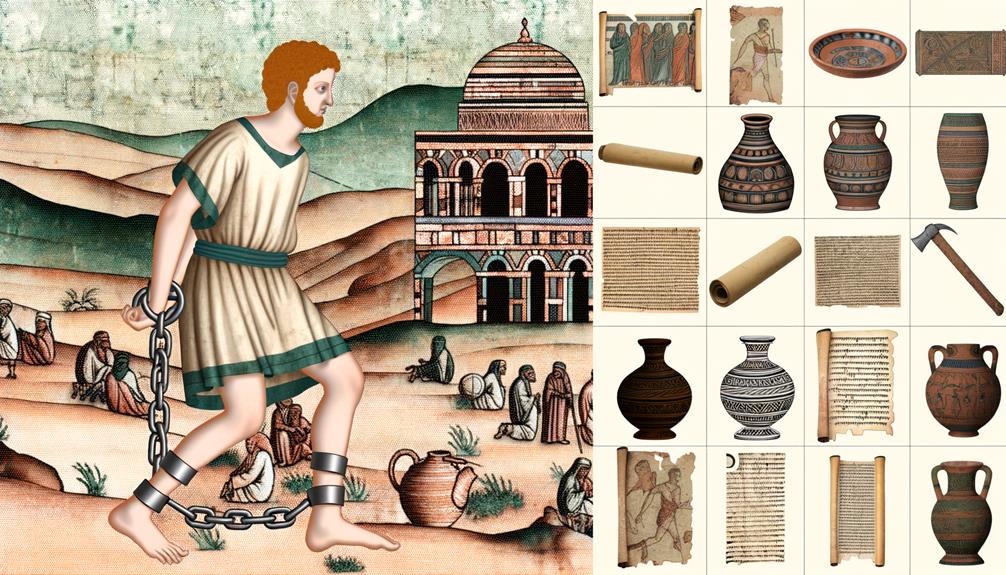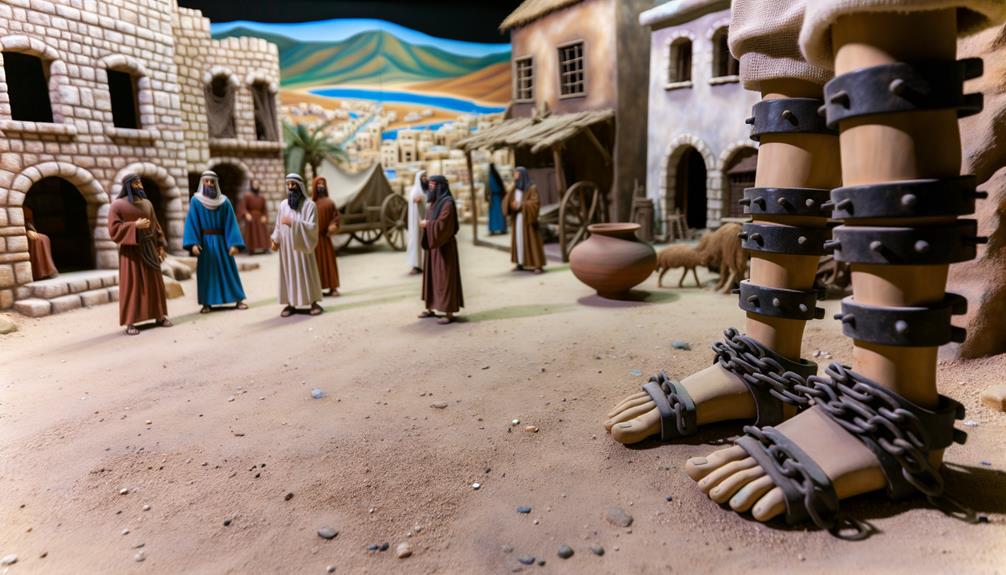Meaning of Leg Chain in the Bible: Bondage and Freedom
In the Bible, leg chains symbolize various forms of bondage and punishment, both physical and spiritual. They appear in contexts reflecting human suffering and subjugation, such as in Jeremiah 40:4 and Psalm 105:18, where leg chains denote captivity and despair.
Historically, leg chains were used as instruments of restraint and visible markers of social status in ancient Near Eastern cultures. Theologically, they represent spiritual captivity and the need for divine liberation, as illustrated in scriptures like Isaiah 45:14.
Understanding these references offers profound insights into themes of divine judgment and redemption. To explore further, consider the multifaceted roles these symbols play in scriptural narratives.

Meaning of Leg Chain in the Bible: Symbolism, Cultural Context, and Spiritual Insight
| Aspect | Details |
|---|---|
| Biblical Reference | Isaiah 3:16–24 |
| Cultural Context | Worn by women as ornaments, associated with vanity and pride |
| Meaning | Symbol of pride, luxury, and later judgment |
| Symbolism | Judgment against arrogance, outward beauty vs. inner spirit |
| Spiritual Insight | Warns against vanity and calls for humility before God |
| Usage in Scripture | Associated with God’s judgment on the daughters of Zion |
Biblical References to Leg Chains

In the Bible, leg chains are often referenced in contexts that symbolize bondage, punishment, and subjugation, reflecting the historical practices and societal norms of ancient times.
For instance, in Jeremiah 40:4, the prophet is released from his chains, symbolizing liberation from captivity. Similarly, Psalm 105:18 recounts Joseph being bound in fetters, illustrating his suffering before divine deliverance.
These references are not merely historical accounts but carry theological significance, portraying God’s intervention in liberating the oppressed.
Additionally, Isaiah 45:14 metaphorically uses chains to describe the subjugation of nations, indicating divine judgment.
Consequently, leg chains in biblical texts serve as powerful symbols, representing both human suffering and the hope of divine liberation.
Historical Context and Usage

Throughout ancient Near Eastern cultures, leg chains were employed as instruments of restraint and humiliation, often used to subdue prisoners and slaves, reflecting the broader societal norms and legal practices of the time. This practice is also evident within scriptural contexts, offering a deeper understanding of its implications:
- Legal Practices: Chains were a legal measure to control captives (Jeremiah 40:1).
- Social Status: They marked a visible symbol of subjugation.
- Punishment: Used as a form of punitive measure (2 Chronicles 33:11).
- Imprisonment: Signified a state of bondage and imprisonment (Psalm 105:18).
This historical context enriches our understanding of biblical references to leg chains.
Symbolism of Bondage

Frequently, biblical references to leg chains serve as poignant symbols of spiritual captivity and moral enslavement, encapsulating a deeper theological message beyond their physical connotations.
In scripture, leg chains often represent the binding nature of sin, as seen in Psalm 107:10, where prisoners sit ‘in darkness and deepest gloom, imprisoned in iron chains of misery.’ This imagery underscores the profound ensnarement and helplessness that sin can impose on the human soul.
Historically, leg chains were literal instruments of bondage, restricting freedom and movement. Theologically, they epitomize the spiritual bondage that separates individuals from divine grace, urging believers to seek liberation through faith and repentance, as emphasized in Galatians 5:1, ‘It is for freedom that Christ has set us free.’
Metaphor for Humility

Leg chains in biblical texts also serve as a powerful metaphor for humility, illustrating the necessity of recognizing one’s limitations and dependence on divine grace. This metaphor underscores several key theological and historical insights:
- Acknowledgment of Sin: Chains remind believers of their inherent sinfulness and need for redemption (Romans 3:23).
- Submission to God: They symbolize the submission required from followers, akin to servants of God (James 4:10).
- Divine Discipline: Leg chains represent God’s loving discipline meant to guide and correct (Hebrews 12:6).
- Human Frailty: They reflect human vulnerability and the need for divine protection (Psalm 91:2).
These elements collectively deepen the understanding of humility in biblical teaching.
Divine Judgment Implications

In biblical contexts, leg chains often symbolize divine judgment, reflecting themes of captivity and restriction as seen in Lamentations 3:7, where the prophet laments being bound by heavy chains.
Historically, such imagery conveys God’s punitive measures against disobedience, illustrating the physical and spiritual limitations imposed upon those who transgress His commandments.
Scriptural references in Jeremiah 40:4 also underscore this notion, portraying leg chains as a sign of punishment and the consequential loss of freedom.
Symbol of Captivity
Throughout biblical history, chains on the legs often symbolized captivity and divine judgment, serving as a tangible representation of God’s retribution against disobedience and sin. This symbolism is deeply rooted in various scriptural narratives and theological interpretations.
- Jeremiah 40:1: The prophet Jeremiah experienced captivity, symbolizing the spiritual bondage of Israel.
- Psalm 107:10-16: Illustrates the plight of those who defied God, bound in iron chains until they repented.
- Acts 16:24: Paul and Silas’ imprisonment with leg chains highlights persecution of the righteous.
- 2 Chronicles 33:11: King Manasseh’s captivity in Babylon as a divine chastisement for his iniquity.
These instances underscore the severe consequences of spiritual waywardness.
Restriction of Movement
The imposition of leg chains in biblical narratives frequently represents a divinely ordained restriction of movement, signifying both physical and spiritual consequences of transgression. This motif is evident in stories such as those of Joseph (Genesis 39:20) and Paul (Acts 16:24), where chains symbolize divine judgment and the resultant curtailment of freedom.
Theologically, leg chains reflect God’s sovereign justice, emphasizing the severe repercussions of disobedience. Historically, they illustrate the tangible consequences faced by those who defy divine commandments. Scripturally, references like Psalm 105:18 accentuate the suffering and spiritual stagnation resulting from sin.
| Biblical Character | Scriptural Reference |
|---|---|
| Joseph | Genesis 39:20 |
| Paul | Acts 16:24 |
| Prophetic Imagery | Isaiah 45:2 |
| Suffering in Chains | Psalm 105:18 |
Sign of Punishment
How does the symbolism of leg chains in biblical texts underscore the concept of divine punishment and the profound implications of God’s judgment?
Leg chains, often mentioned in scripture, serve as a potent symbol of divine retribution and a tangible manifestation of God’s judgment upon those who transgress His commandments. This imagery is deeply embedded in the biblical narrative, reflecting the gravity of divine displeasure.
- Jeremiah 40:1-4: The prophet Jeremiah is set free from chains, symbolizing deliverance from divine punishment.
- Acts 12:6: Peter’s chains fell off, signifying divine intervention and mercy.
- Lamentations 3:7: Chains represent the heavy burden of sin and divine judgment.
- Isaiah 52:2: Zion is called to shake off chains, indicating liberation from God’s wrath.
These references elucidate the theological and historical significance of leg chains as symbols of divine judgment.
Cultural Significance in Ancient Times

In ancient cultures, leg chains often carried profound symbolic meanings, ranging from indicators of subjugation to representations of spiritual bondage, as highlighted in scriptural passages such as Isaiah 3:18-20.
These chains also played a role in religious rituals, serving as tangible reminders of one’s devotion or penance.
Furthermore, leg chains could signify social status, distinguishing between different classes within the societal hierarchy.
Symbolism in Ancient Cultures
Ancient cultures often imbued leg chains with profound symbolic meaning, intertwining them with themes of servitude, status, and spiritual significance as evidenced in various historical and scriptural contexts.
Theological insights and historical records reveal:
- Servitude: Leg chains often symbolized bondage and subjugation, as seen in the enslavement practices of ancient civilizations.
- Status: They served as indicators of social rank, with ornate designs reserved for nobility and the affluent.
- Punishment: Ancient texts describe their use in penance and retribution, highlighting moral and judicial dimensions.
- Spirituality: Some cultures viewed leg chains as talismans, believed to protect from evil spirits or to signify religious devotion.
This multifaceted symbolism underscores their cultural and theological relevance.
Religious Rituals and Leg Chains
Religious rituals in ancient times frequently incorporated leg chains, reflecting their deep cultural significance and symbolic resonance within sacred practices and ceremonies. These chains, often referenced in biblical texts, were not merely ornamental but held profound theological implications.
For instance, leg chains in sacrificial rites symbolized submission to divine authority, as seen in the practices of ancient Israelite traditions.
| Aspect | Example | Scriptural Reference |
|---|---|---|
| Symbolism | Submission to God | Isaiah 3:16-20 |
| Ritual Usage | Sacrificial ceremonies | Leviticus 8:7-9 |
| Cultural Context | Reflecting spiritual status | Ezekiel 16:10-14 |
Understanding the historical and scriptural context of leg chains enriches our grasp of their multifaceted roles in ancient religious observances.
Social Status Indicators
Leg chains frequently served as markers of social status in ancient biblical societies, reflecting one’s position and role within the community. These adornments were not merely decorative but carried significant cultural implications.
Wealth, authority, and servitude could be conveyed through the presence or absence of leg chains.
- Wealth: Often, the quality and material of leg chains indicated one’s financial standing (e.g., gold or bronze).
- Authority: Leaders and figures of power might wear distinctive chains to signify their rank.
- Servitude: Conversely, slaves or prisoners might bear leg chains as symbols of their subjugated status.
- Cultural Identity: Specific tribes or groups used unique designs to denote identity.
This multifaceted symbolism underscores the complex social hierarchies present in biblical times.
Modern Interpretations and Lessons

In contemporary theology, the depiction of chains in biblical texts often symbolizes spiritual bondage and liberation, inviting believers to reflect on their own spiritual journey and the transformative power of faith.
Historically, chains have represented captivity, as seen in Paul’s imprisonment (Philippians 1:13-14), illustrating the trials faced by early Christians.
Scripturally, the breaking of chains signifies divine intervention and freedom, echoing Psalms 107:14, which speaks of God breaking ‘their chains asunder.’
Modern interpretations encourage believers to recognize personal and societal forms of bondage, urging them to seek spiritual emancipation through Christ.
This theological reflection underscores the enduring relevance of biblical symbols, inspiring contemporary Christians to pursue a life of faith, resilience, and spiritual liberation.
Conclusion
The biblical depiction of leg chains encapsulates themes of bondage, humility, and divine judgment, reflective of the historical and cultural milieu of ancient times.
Such symbols served as reminders of human frailty and the potential for divine retribution.
How does one reconcile the use of physical restraints with the overarching message of spiritual liberation found in scripture?
Modern interpretations continue to draw lessons from these ancient symbols, underscoring the perennial struggle between human limitation and divine grace.






